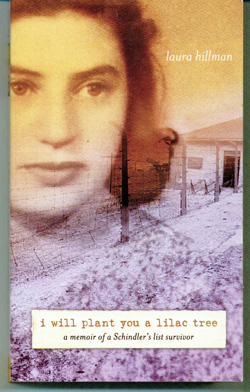I Will Plant You A Lilac Tree: A Memoir of a Schindler’s List Survivor by Laura Hillman; Simon Pulse, 2005; ISBN-13 978-1-4169-5366-1, paperback, 271 pages.
By Donald H. Harrison

SAN DIEGO — I met Laura Hillman recently at the 105th birthday party for Laura Simon in San Diego. When I learned that she had written a book for teenagers about her Holocaust experiences, I asked for the opportunity to read and review it, notwithstanding the fact that it has been available now for some five years.
Hillman has a clear, easily understandable, narrative style perhaps fashioned from many years of personal appearances in high school classrooms, at Holocaust assemblies, and as a docent at the Long Beach Museum of Art.
 Her book relates her experiences as Jewish teenager Hannelore (Laura) Wolff in Nazi Germany and takes us through her deportation to various work camps in Poland and eventually to the infamous Auschwitz-Birkenau death camp. But somehow, perhaps because Hannelore spoke German, a prison commandant decided to put her name on the list of Jews who eventually would be transported to an ammunition factory owned by Oskar Schindler (known to most of us from the Schindler’s List movie). There, as a cook for SS guards, she survived through the end of the war.
Her book relates her experiences as Jewish teenager Hannelore (Laura) Wolff in Nazi Germany and takes us through her deportation to various work camps in Poland and eventually to the infamous Auschwitz-Birkenau death camp. But somehow, perhaps because Hannelore spoke German, a prison commandant decided to put her name on the list of Jews who eventually would be transported to an ammunition factory owned by Oskar Schindler (known to most of us from the Schindler’s List movie). There, as a cook for SS guards, she survived through the end of the war.
The story is an uplifting one, about the survival and eventual triumph of the human spirit, even in the face of the most degrading circumstances. In her journey through the Nazi hell, Hannalore met Bernhard (Dick) Hillmann, a fellow Jewish inmate with whom she fell in love, despite only very brief and limited contacts.
When the spirit of one would be on the verge of being crushed , the other would help rally optimism that someday the war would be over, that they would be free, and that they could reclaim their lives. Hannelore told Dick about the lilac tree in her native town of Aurich (near the North Sea), which bloomed on the birthday of her mother, from whom she had been separated by the Nazis. Dick promised that after the war, he would plant for her a lilac tree—thus the title of the book.
Holocaust memoirs have a way of following a general pattern because the Nazis mechanized the process of mass murder. Depending on how familiar a reader is with this process, different parts of an author’s narrative will stand out. I shall be able to recall from this book two passages, in particular. One was about roll calls, that could take hours, often in inclement weather, that were part of the routine of the Nazi camps. Laura Hillman writes convincingly how she was able, during these times, to escape into her dreams, to imagine herself once again indulging her senses of taste and smell as baked goods were served to her.
The other part I shall remember was her account about being part of a group of women who were marched naked into a room where they were told they would have a “shower.” She and a friend had heard about the gas chambers made to look like showers and were certain their lives would end in moments. They held on to each other, not wanting to face their deaths alone. Then water came out of the shower heads; it was a shower indeed! In excitement and relief, the women danced.
Simon & Schuster which published this book under its Simon Pulse imprint, clearly knows its business. It chose in Hillman’s account a book that will both horrify and uplift teen readers as they learn about Nazi inhumanity and about the resilience of some victims. Adults, too, will find the account edifying.
*
Harrison is editor of San Diego Jewish World